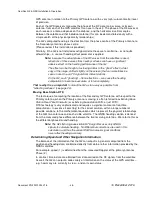
ComNav G2 & G2B Installation & Operation
Document PN 29010093 V1.5
- 44 -
16 December 2016
Thus, it is best to turn on the G2 and run it for a few minutes, before turning on your other
equipment.
Determining Position
The Global Positioning Systems are essentially timing-based position trilateration systems.
The G2’s GNSS receivers automatically and continuously try to receive RF signals from all
GPS and GLONASS satellites that are visible in the sky. To determine its own geographic
position, the G2’s GNSS receivers use a complex algorithm incorporating satellite locations
and ranges to each satellite. The ranges are calculated by determining how long it takes for
the RF signals transmitted from each visible satellite to reach the G2’s two antennae, using
information carried on those RF signals.
If the signal from a visible satellite is of sufficient quality (i.e., strong enough, and with low
noise & errors), the G2’s receivers are able to decode the information on the RF signals, and
thus to calculate the range to that satellite.
Reception of good-quality signals from at least four GNSS satellites allows the G2’s GNSS
receivers to compute accurate, high-precision 3-dimensional position coordinates.
Positions computed by the G2 are based on the RF phase centre of the Primary antenna
(see page 44).
Differential Corrections
There is usually some error in GNSS positions, from any brand of GNSS receiver. Errors can
be caused by many things: Selective Availability, atmospheric effects, timing errors and
satellite orbit perturbations are some examples.
.
But, to improve the accuracy of position computations even more, the G2 can also acquire
and use Differential GPS (DGPS) correction data, from one of several possible sources:
•
Space-Based Augmentation System (SBAS) satellites, if the G2 is located where one
(or more) operational SBAS satellites are visible to it, and if the SBAS data being
transmitted by those satellite(s) is valid for the G2’s location.
The G2 automatically scans for and tracks SBAS satellites. It has two-channel
tracking capability, which enhances its ability to maintain a lock on a specific SBAS
satellite when more than one satellite is in view, and thus provides more consistent
tracking.
Current SBAS systems that the G2 can use include WAAS, EGNOS and MSAS;
other compatible systems may be operational in future – SNAS, GAGAN, etc.
•
An external data source sending RTCM SC-104 DGPS data to the G2 (via its RS-422
Port 2 or RS232 Port 1).
The G2B can also use:
•
Conventional terrestrial DGPS Radiobeacon signals.
Marine authorities in many countries around the world have installed networks of
Radiobeacon transmitters, which broadcast DGPS corrections valid in the vicinity of
each such transmitter.
Determining Heading
Satellite visibility & signal quality are again important to how well the G2 operates, in
computing heading. Signals from
all
visible satellites are used – even any not being used in
the position computations described above.
In other words … the more satellites which are visible, the better!
The G2’s GPS engine uses both the data carried on the RF signal from GPS satellites, and
measurements of the RF carrier wave’s phase, to compute the location of the Secondary
Summary of Contents for Vector G2
Page 2: ......
Page 6: ...ComNav G2 G2B Installation Operation Document PN 29010093 V1 5 4 16 December 2016...
Page 12: ...ComNav G2 G2B Installation Operation Document PN 29010093 V1 5 10 16 December 2016...
Page 14: ...ComNav G2 G2B Installation Operation Document PN 29010093 V1 5 12 16 December 2016...
Page 19: ...ComNav G2 G2B Installation Operation Document PN 29010093 V1 5 17 16 December 2016...
Page 43: ...ComNav G2 G2B Installation Operation Document PN 29010093 V1 5 41 16 December 2016 Operation...
Page 44: ...ComNav G2 G2B Installation Operation Document PN 29010093 V1 5 42 16 December 2016...
Page 59: ...ComNav G2 G2B Installation Operation Document PN 29010093 V1 5 57 16 December 2016...
Page 83: ...ComNav G3 G3B Installation Operation Document PN 29010093 V1 5 81 16 December 2016...
Page 84: ...ComNav G3 G3B Installation Operation Document PN 29010093 V1 5 82 16 December 2016 Index...
Page 85: ...ComNav G3 G3B Installation Operation Document PN 29010093 V1 5 83 16 December 2016...
Page 87: ...ComNav G2 G2B Installation Operation Document PN 29010093 V1 5 85 16 December 2016...
Page 88: ...ComNav G2 G2B Installation Operation Document PN 29010093 V1 5 86 16 December 2016 User Notes...
Page 89: ...ComNav G2 G2B Installation Operation Document PN 29010093 V1 5 87 16 December 2016...
































